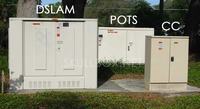okular766 wrote:
If I take Netie, I will have more or the same?
So I'll never get more than 5Mbps again? There is nothing to delude yourself? ?
Who knows that? It depends on the condition of the cables, how much to DSLAM, interference from the environment ... Anything on the line and it can change for better or worse. In fact, according to my observations, even the season of the year matters.

(Although I do not fully understand the mechanism of this phenomenon.) The only method is to check, the rest is almost reading coffee grounds.
okular766 wrote: But you wrote yourself with a twisted pair for PLN 1 = 1m provides 1GB / s
Have you read my previous post? I do not think so...
okular766 wrote: the technology is probably high because ADSL and not a modem
ADSL is a modem technique.

It is further a modem, just more advanced and using a different infrastructure on the operator's side than the old analog dial-ups. But, as I wrote a few lines before and as others wrote, it all depends on the "cable".



